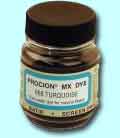advertisements
Disposable Gloves

Procion MX Fiber Reactive Dye

Don't use bleach! It is far more toxic than the dyes. Too much exposure to hypochlorite bleach can burn your skin or make you very sick.
You should always wear gloves when working with any dye. The dyes we usually work with are reasonably non-toxic, but they have not been tested thoroughly for longterm safety. It's prudent to act as though they are dangerous, and keep them off of you. Sometimes a glove gets a hole in it, though. What do you do then?
The best solution, after an ordinary scrubbing with mild soap, is simple patience. Fiber reactive dyes such as Procion MX type dyes have the useful property of not penetrating living cells, so the dye is only in the topmost layer of dead skin cells that you always have, serving to protect the living skin cells underneath. As these cells are shed frequently, the color should be gone within one to three days of normal wear and hand-washing.
To speed things up, exfoliate, as the cosmetologists say. Use a pumice stone or a loofah, or any other sort of skin scrubber; don't remove too much of the protective layer of dead cells, though, or your hands will hurt! Results are best if you avoid exfoliation for several days before dyeing. Then the build-up of dead skin cells acts as a natural protectant - not sufficient to substitute for gloves, by any means, but useful if you get a few drips on your legs, say.
You can buy a special hand cleaner, ReDuRan, from many dye suppliers. This cleaner is formulated specifically for the removal of dyes. Some find it to be very helpful. I personally find it only slightly more effective than ordinary scrubbing, and it smells truly horrible, so I rarely use it even when I have it handy. The problem is that Reduran works well only if used before you use any water, but most dye stains come off with soap and water alone, so you don't know whether you really need the Reduran until it's too late.
I have a tube of silicone-based "invisible glove" cream; I have never remembered to try this before dyeing, so I don't know whether it will help at all. I do wear gloves, but the thin gloves I prefer do often get holes in them.
As far as the skin is concerned, the slightly caustic property of the sodium carbonate used to fix the dye is a much greater concern than the dye, as it is quite drying to the skin. Unless you have very oily fingers, tie-dyeing without gloves can result in somewhat painful splits in the skin all over the hands. Immediately washing, or at least wiping, the soda ash off of the skin can prevent this discomfort.
 Back to list of FAQs
Back to list of FAQsAll of the pages on this site are copyright ©1998‑2025 Paula E. Burch, Ph.D.
Page created: August 11, 2002
Page updated: August 7, 2006
Downloaded: Sunday, December 07, 2025